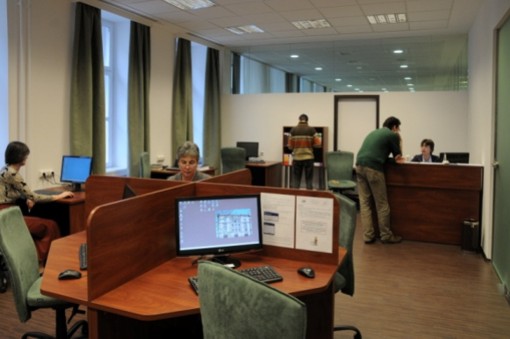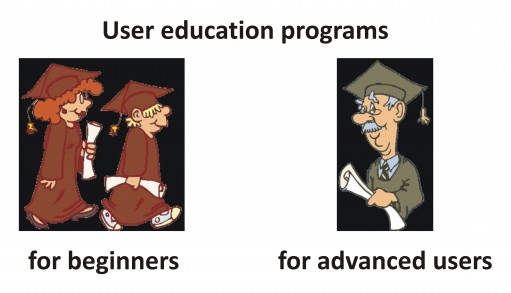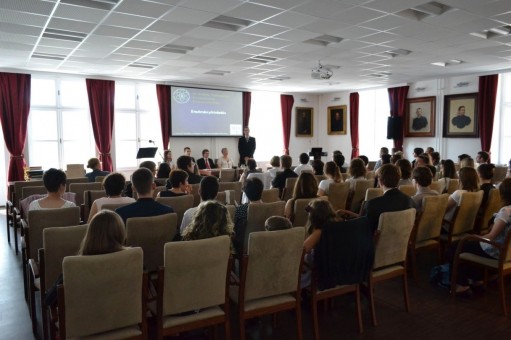Since its foundation in 1826 the Library of the Hungarian Academy of Sciences has dedicated itself to supporting scientific and scholarly research and safeguarding its precious collections for future generations. Preserving its traditional values and relying on state-of-the-art information technology it serves the public by making its holdings accessible to an ever-expanding circle of users.
Information technology has determined the ways of development since the 1980s but at that time computers were used for traditional functions mainly to provide quick and up-to-date services by applying integrated library systems.
The 21st century has brought innovative solutions to libraries, mainly with the spread of electronic publications. The Academy’s Library is a hybrid library of the traditional paper based collection and the modern electronic library. As far as periodicals are concerned e-only access has grown rapidly and has overgrown the print collection by now. The book collection is still paper-based mainly but the growing number of e-books is evidence in this area as well.
The collection
The Academy’s Library is a national research library. Due to the fact that the Library had the right to develop its collection through legal deposit from 1836 till 1998; and partly as a leading organization in international exchange programmes it has a precious unique collection of more than 2.3 million items.
The special collections, such as the Oriental Collection and the Rare Books and Manuscript Collection have international reputation and are acknowledged by researchers worldwide.
The 2,3 million volume paper collection in a variety of formats is still increasing every year, but much less book is purchased that in previous years. Manuscripts are showing a rapid increase and in the digital age they seem to be valued more than ever before. E-periodicals are far more heavily used than print ones, though in the humanities the change is not that rapid than in hard sciences. Scholarly communication in the era of electronic publications resulted that former clear collection development policy has changed, and ‘big deal’ packages get into the library expanding the scope of the collection. At present nearly 19 000 periodical titles can be accessed via library IP addresses covering all subject fields.
International exchange was one of the strongest collection development elements of the library, especially during the times of ideological barriers, before 1989. Today financial barrier and the spread of electronic publications result the fallback of international exchange and switch to e-exchange. Turning back to the original mission of the Academy, namely preserving and developing Hungarian language, is the main focus of our exchange program. The reduction of exchange and the introduction of e-exchange lowered the costs of our exchange program by one third in 2012. The save on postage is worth mentioning.
Digitization
Preserving and archiving the manuscripts and the print items of the collection lead to digitization, which is not mass digitization of the full collection, but a result of careful selection and prioritization due to limited funding. We digitize individual items upon user request for a so called preservation fee; and we also digitize parts of our special collections upon some anniversary or celebration of some authors or special items. So, digital collections of famous authors and/or famous items are created regularly. These collections are enriched by research papers, scientific articles and useful notes and bibliographies, creating an understandable context for the digitized materials.
19 digital collections are accessible through our homepage http://konyvtar.mta.hu and show a great variety of topics from the Oriental Collection and the Manuscript and Rare Book Collections.
National image library of pictures, photos, art pieces, portraits, illustrations, etc. is a nationwide project started in 2008. Our library contributed more than 2500 items, mainly photos from our special collections. Furthermore six various research institutions of the Hungarian Academy of Sciences put their share in this project, so the Academy’s information asset is well represented here.
Repository of the Academy’s Library (REAL)
As an experimental project to structure the isolated pieces of our e-collection we started the development of a repository named REAL; a green road repository in 2009.
At present 465 Academy’s Doctoral thesis and 3684 National Science Fund (OTKA) supported research papers project reports are accessible in REAL. (http://real.mtak.hu)
The president of the Hungarian Academy of Sciences issued an Open Access Mandate in 2012 stating that research results achieved by public fund have to be made publicly available. So REAL repository is recommended as one option to place publications as research papers in.
Services
The Library serves the public by providing its holdings to an ever widening circle of users. EoD project is an experiment for E-book on demand. Considering copyright issues the online catalog has a special EoD collection that shows all titles that can be ordered by users as they are exempt of any copyright restrictions.
Reprography is expanded due to ICT development: digitization is one of the most common services provided for a fee. In most cases a preservation fee is charged for. Copying has changed to free-of-charge download and scanning mainly.
Digital study room opened in 2010
(Pro zvětšení obrázku na něj klikněte)
It is important to state that virtual users are increasing rapidly, while registered users and visitors at our library sites are showing a decreasing number. This is a world tendency, no surprise at all, but gives signal to librarians to prepare for the switch in usage. We have to be prepared for virtual usage as much as possible and turn our collection and services inside out in order to make it usable and useful.
| year | virtual users via homepage | registered users | active users |
| 2011 | 770 000 | 4 780 | 3 812 |
| 2012 | 1 158 000 | 5 183 | 3 551 |
| year | Minerva online user education | user ed. course participants |
| 2011 | – | 329 |
| 2012 | 4 300 | 208 |
Information literacy programs grew out of our user education programs and even though we are not an educational institution, they seem to be successful and show clearly, how important it is to give compass to users in the Internet jungle.
Agora
We organize different events biweekly in order to attract a wider audience than the regular library users. Due to some reconstruction work on the second floor of the library in 2010, a conference room was created where max. 120 people can be seated. We organize programmes when friends of the library give lectures and present on some research topic and/or on publishing a book, etc. We have a series called “Let’s make the collection live” when different unique pieces of the special collections are presented, when digitized items are shown to the public, or celebrating anniversaries of authors by organizing exhibitions or having round table discussions, and so on. These programmes are very attractive and they are more popular for media coverage than regular or traditional library activities.
Conference room at the 2nd floor of the library
(Pro zvětšení obrázku na něj klikněte)
Nationwide projects
Two nationwide projects were allocated to the Library in 2012 that gave the base for incorporating ‘Information Centre’ to the name of the Library. These nationwide projects give the safe and secure operation for us and at the same time challenges all professional staff to renew skills regularly and to prepare for new and innovative solutions on the basis of solid professional knowledge.
- Electronic Information Services (EISZ) is an 11 year-old program that last year was placed to the Hungarian Academy of Sciences and government funding was allocated to the Academy’s Library. This nationwide collection development project aims to provide the basis of information infrastructure for research and higher education in Hungary. National license agreements are prepared and signed yearly with publishers and/or vendors and database access is provided to higher education and research institutions that fill in a needs assessment survey every year and state that are ready to contribute to the costs as self-share.
- The Hungarian National Scientific Bibliography[1] (MTMT) aims to create a comprehensive national scientific bibliography of all researchers working in Hungary, affiliated to Hungarian institutions, funded by Hungarian grants or participating in the scientific life of the country in other ways. It is working as a consortium of 35 members already. The database under development aims to serve also as a citation database, creating the basis for scientific achievement measures. A government grant with EU funding supports the project to reach its full potential by the end of 2014.
-
Holl, A. – Makara, G.: Links and hubs of scientific information – the case of the MTMT (2012.) www.mtmt.hu



